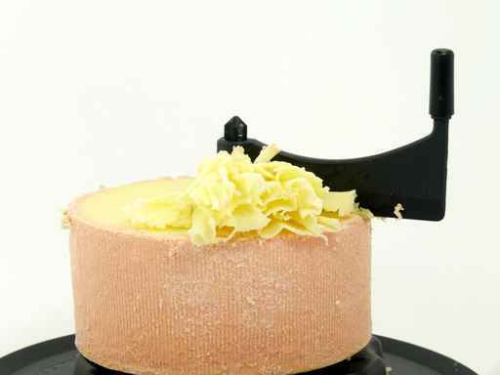
"Monk's head" cheese is a Swiss favorite, best served fresh, though it's also packaged for supermarkets and even the Swiss airline. (Photo provided to China Daily)
Justly famous for cheese and chocolate, the Swiss table celebrates three neighboring cultures-Germany, France and Italy-while delivering flavors entirely its own.
The blade sweeps merrily across the top of a big round of cheese, and the resulting shavings pile up like a translucent yellow ribbon. When the carving stops, we reach in eagerly to taste the Tete de Moine, a proudly Swiss cheese that literally translates as "monk's head". The semi-hard cheese was first made more than 800 years ago by French-speaking monks of the abbey of Bellelay, and the careful scraping with a knife's edge, allowing oxygen to reach more of the surface, opens up its nutty aroma and flavor.
Our hungry group nibbles and nods appreciatively, lingering a little longer here to study the girolle, the tool Swiss chefs use to carve pretty rosettes of the cheese we're eating. The 12th-century monks who invented this whole-milk cheese would have been equally intrigued: the girolle was only invented in 1982 for its flowery effect. Before that, centuries of cheese-makers used simple kitchen knives to harvest the savory goodness. Today the top-cutting blade is popular with professional chefs and home cooks alike, and supermarkets have them on offer for tourists seeking a cool souvenir of their visit to Switzerland.
The Tete de Moine-reputedly so named because the method of serving suggested the way a tonsure is shaved on a monk's head-is just one of the culinary delights presented to our touring group by our hosts at Zurich's Swissotel. All around us, at a pre-dinner buffet, there is a bounty of local produce.
Besides the array of cheeses and chocolates we expect, there are thin slices of sweet air-dried beef as well as sausages, veal in cream sauce, rare salamis and rye bread served with our choice of butter or moutarde de Benichon, a thick mustard made with sugar, flour, spices and cooked wine must-the freshly pressed juice that contains the skins, seeds and stems of the grapes that is sometimes dubbed "young wine".
In a world that has become so globalized, Swiss wines are a refreshing surprise. The nation exports less than 5 percent of its wines, our hosts say, so these vintages can rarely be enjoyed without being in the neighborhood of the harvest. Most of the production comes from the south, in the French-speaking districts around Lake Geneva.
We are particularly impressed by a crisp white wine from the picturesque terraced vineyards of Lavaux, a UNESCO World Heritage site between Lausanne and Montreaux. ("This is a wine you may sometimes be able to find at the Swissotel in Beijing," the food-and-beverage manager confides.)
Duly noted-that will leave room in the suitcase for other goodies. That, of course, means lots of chocolate for our friends back home, as well as the careful preparations of cherry, apricot and other fruits that the Swiss use for brilliant desserts.
Dense syrups and compotes-and zesty liqueurs-make the most of regional apricots, plums and sweet black cherries that are harvested and preserved for later baking or simply spreading on crusty fresh bread. After munching a kirschtorte (cherry cake made with an indecent amount of almond paste and butter cream), I make sure to collect a bottle of the kirsch to take home. If I am not ambitious enough to make the cake when I get to my Beijing kitchen, the cherry liqueur can simply be added to a glass of sparkling wine for easy enjoyment.
Other sweet treats must be savored on the spot. Apple strudel is easy to find in Swiss cafes, but a more specifically local treat was the Botzi pear, a treasure of the Gruyere region. Gruyere, of course, produces a great cheese-the country, in fact, produces more than 450 different types of cheese, almost all without the holes outsiders tend to associate with "Swiss" cheese. A dairy area that produces great cheese unsurprising also produces fresh cream, and Gruyere's super-thick version is popularly served with the local pear and meringues.
Then, of course, there is chocolate. The Swiss variety has been famous for a couple of centuries, thanks to folks like Henri Nestle, Jean Tobler and Rodolphe Lindt. Their names emblazon shops across the country, indeed the world-but surprisingly half of the chocolate made in Switzerland is eaten there. Lindt-where the founder invented the aeration process that makes chocolate candy melt in your mouth-is a key stop on Zurich's chocolate-themed tours. So is Cafe Sprungli, famous for Swiss sweets since 1836.
And what would a Swiss ski resort be without a fragrant cup of hot chocolate?


















































